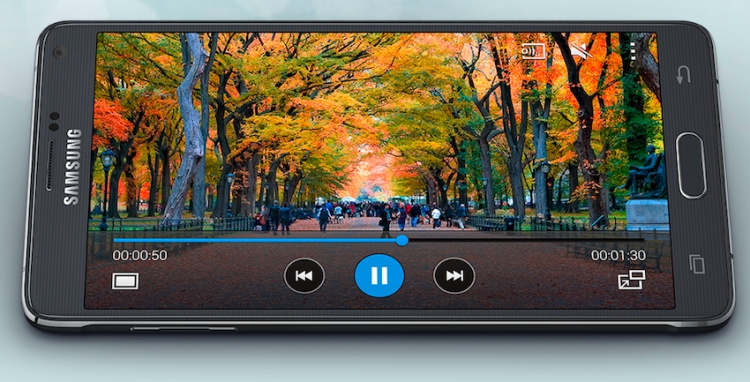The growing popularity of large-screen mobile devices is having a big effect on mobile ads. That’s one of the takeaways from the new Adobe Digital Index’s Q4 Digital Advertising Benchmark report, released today.
Bigger smartphones, as well as phablets and tablets, mean that more of the clicks on ads are intentional — and fewer are “fat finger” accidental ones.
Fingers tapping what people actually want appears to be affecting both clickthrough rates (CTR) and cost-per-click rates (CPCs) for mobile ads.
Clickthrough rates for mobile devices saw a big boost in the report, 27 percent year-over-year for tablets and 26 percent for smartphones. This, in turn, has driven a 19 percent increase in CTR for Google advertisers in general (Q4 year-over-year).
The much higher CTR also represents a more efficient ad spend, the report noted, since the cost-per-click (CPC) rates are up only 8 percent on Google. In other words, it’s more return for the buck. Yahoo/Bing, the report said, is not so efficiently optimized, as CPC there is up 7 percent year-over-year while CTR growth is zero.
“The tablet is a great interface,” director of product marketing Tim Waddell told VentureBeat. “The engagement rate is great and the [sales] conversion is great.” So, he said, it makes sense that the same interaction pattern would apply to the new wave of larger screen mobile devices, like the Samsung Galaxy Note 4.
‘Kind of war going on’
While the Adobe report doesn’t break down ad stats by screen size, principal analyst Tamara Gaffney told us there was “an indication” that the rise in clickthroughs was a result of the growth in larger screens.
And it is enough of an indication for her to predict that “as a result of larger screen smartphones, the value of CPC [cost-per-click] will increase.”
“Based on larger screen phones already in the market, we know that retail conversion and media consumption rates go up as screens get larger,” she said. And, as sales conversions increase, the clicks become more valuable.
VentureBeat is studying marketing clouds.
Answer our survey now and we’ll share the results with you.
Gaffney described as “surprising” the fact that Yahoo/Bing CPC growth rates are about the same as Google’s, even though their CTR growth is flat. It’s “indicative of marketers spreading out their money [through] more tools that allow programmatic buying,” she said. Programmatic buying enables them to quickly maneuver as ad rates change so they can get the best return-on-investment, such as by finding effective places to run their ads.
“There’s a kind of war going on,” she added, where “marketers seem to be figuring out how to optimize their spend” through their automated tools.
Another takeaway: The spend on Google’s “Shopping Ads” ballooned during the just-passed holiday season, nearly eight times that of text ads. Year-over-year, Shopping Ads spend is up 47 percent.
Google’s Shopping Ads — which used to be called Product Listing Ads — are those image-based promotions that appear when you search for a product. The images and their positioning at the top of a results page appear to be making a big difference.
Whither text ads?
Shopping Ads represent about one-fifth of all retail search engine marketing in the U.S., the report said. Adobe is predicting that they will grow to nearly a third by 2015’s holiday season, and that nonretailers will also begin adopting them as visually based ads take a greater role in Google results.
By contrast, Yahoo/Bing’s Product Ads — released in March of last year — represented less than one percent of U.S. retail clicks.
In the retail sector, Google Text Ad spending is down 6 percent, year-over-year. The modest drop in Text Ad spending is surprising, Gaffney said, given that it is the reigning ad type.
“Text ads are still the big kahuna of search,” she noted, since they account for two-thirds of U.S. retail clicks. But the question is: for how much longer, given Shopping Ads’ growth and Text Ads’ decline?
The data also shows that more mobile search is happening on Sundays and more desktop search on Mondays. Which makes sense, since people are out and about on the weekends and back at their desks on Monday.
It also appears that retailers are adjusting to Facebook’s change in its newsfeed algorithm, which has reduced organic brand posts to a trickle. Adobe predicts that Facebook organic impressions will plunge another 40 percent by next year.
“Organic,” Gaffney said, “is toast in Facebook for brands.” She said the fact that “it didn’t take long for brands to adjust [is] indicative of how important Facebook is to their mix.”
Paid impressions on Facebook by retailers were up 13 percent year-over-year for Q4, but boomed 53 percent compared to Q4 of 2013. Organic impressions, however, were down 32 percent year-over-year.
“Facebook aggressively makes it more difficult for brands to be successful on its platform without adopting their pay-to-play system of advertising,” Adobe said in its report.
The report draws on Adobe Marketing Cloud’s Adobe Media Optimizer and Adobe Social’s huge dataset of anonymous visits to brand websites from fourth quarter of 2013 to the same quarter last year. It also includes 400 billion Facebook post impressions and 500 billion Google and Yahoo/Bing ad impressions.
VentureBeat's mission is to be a digital town square for technical decision-makers to gain knowledge about transformative enterprise technology and transact. Learn More



